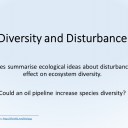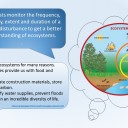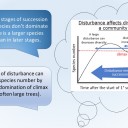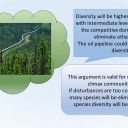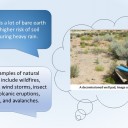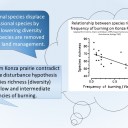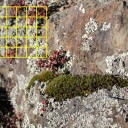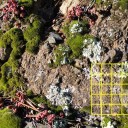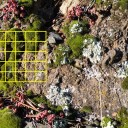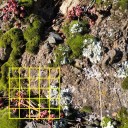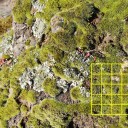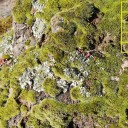Disturbance vs Diversity
.jpg) Disturbance influences the structure and rate of change within ecosystems. This activity gives students some information about the role of disturbance in communities and asks them to use the information to argue that oil pipelines can increase diversity, and then why they might harm a climax forest community. A short practical activity to illustrate this sort of ecological study follows and an online analysis of some photographs showing primary succession completes the activity.
Disturbance influences the structure and rate of change within ecosystems. This activity gives students some information about the role of disturbance in communities and asks them to use the information to argue that oil pipelines can increase diversity, and then why they might harm a climax forest community. A short practical activity to illustrate this sort of ecological study follows and an online analysis of some photographs showing primary succession completes the activity.
Lesson Description
Guiding Question
Who is right? Some people claim that disturbance in natural environments is not a new thing, They say, "Human activity doesn't cause as much damage to diversity as we think". Others campaign hard to protect the natural environment from change. Which argument is best supported by the evidence?
.jpg) |  |
Activity 1 - Diversity and disturbance
Disturbance is a really important component of natural ecosystems. Read the following quote from Grate Lakes Inform, a collaboration between The Nature Conservancy, the U.S. Geological Survey, and the Upper Midwest & Great Lakes Landscape Conservation Cooperative
Natural Disturbance
The power of nature can be unrelenting, but it can also be a necessary force in the development and maintenance of Great Lakes habitats. Great Lakes species have evolved to particular disturbance regimes that shape the environmental conditions. Fire is a common natural disturbance in the Great Lakes region, which can vary from frequent low intensity burns to large-scale stand-replacing fires that only occur once every hundred years.
Use the following slides to explore the idea that disturbance can increase diversity. Then use the information to construct an argument in favour of oil pipelines in Alaskan or Canadian forests and then one against the benefit of human disturbance of this kind. See the worksheet below.
Cut out and arrange the statements on the ![]() Diversity and disturbance student worksheet to form your arguments for and against the oil pipeline. Add any extra ideas yourself of course to complete each argument.
Diversity and disturbance student worksheet to form your arguments for and against the oil pipeline. Add any extra ideas yourself of course to complete each argument.
Activity 2 - Experiment measuring effects of disturbance on the local environment.
It is usually possible to find some examples of human disturbance in the local environment. This could be a simple worn area on the corner of a lawn, or the goal mouth of a football pitch. Investigate one of these areas using the worksheet ![]() Simple ecological disturbance and diversity experiment. This could give ideas for the individual Investigation.
Simple ecological disturbance and diversity experiment. This could give ideas for the individual Investigation.
Activity 3 - Simulation of a simple ecological study of primary succession
Use the gallery of images below to record the changes in 'bare rock' and in 'species number' over the 5 years of photos. Each image has a randomly place quadrat frame on it.
The plants visible in the photos could be described using these simple names:
- Grey leafy lichen
- Orange lichen
- Black encrusting lichen
- Green Moss
- Red stonewort
Teacher's notes
The posters shown at the top of the page are designed to provoke a response from students and to engage their interest. Of course, while the construction of an oil pipeline may clear areas of forest and allow new species to grow around the pipeline, there are also significant risks to the environment from the potential leakage of oil. These risks are clearly outlined in these pages from Greenpeace McMurdo. It is worth noting that Greenpeace, like the oil industry, do not usually do scientific studies themselves to confirm their arguments.
The slides in activity 1 could be used as a introduction to the idea that climax communities are not always as diverse as sub-climax communities. This is particularly true where there is natural grazing, or regular fires. Explaining the idea that succession is an ongoing process in ecosystems, periodically reversed by disturbance is a good way to ensure that student understand these concepts.
Activity 2 and 3 could be seen as alternatives. The practical fieldwork would make a good preparation lab for an individual investigation.
Further reading
The University of Idaho has a page of excellent notes about the design of an ecological study, with reference to quadrat shape and size. Perfect for students using quadrat sampling for their Individual investigation.
These links to ecological research papers are quite readable and perhaps interesting for some students.
- Good readable information about disturbance in the great lakes
- Ecological paper about USA oil pad regeneration - very readable
- Read page 5 of this ecology research paper which explains why disturbance increases diversity, according to immigration and emigration.
- This is another paper which explores the role of disturbance and diversity. It tests two hypotheses about disturbance and concludes that disturbance only provides the opportunity for increased species richness in certain cases.
This interesting flash animation may be useful to review successtion /files/biology/files/activity%20worksheets/options/opc/succession.swf.

 IB Docs (2) Team
IB Docs (2) Team

